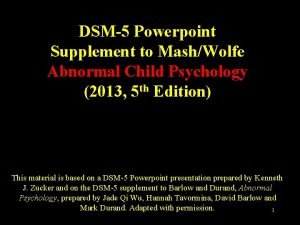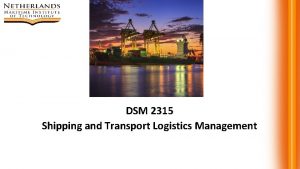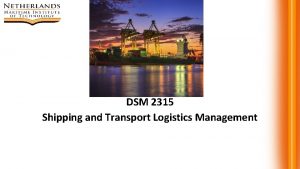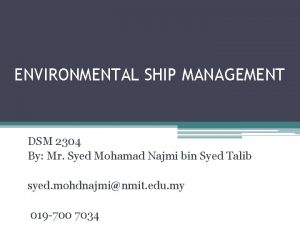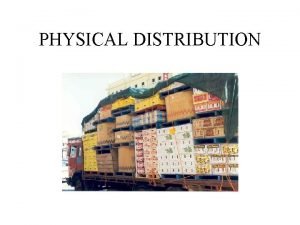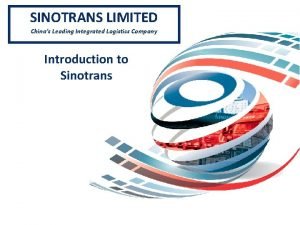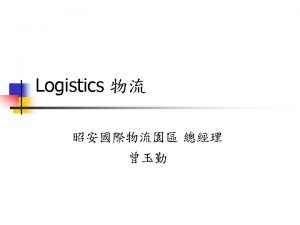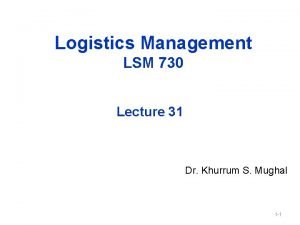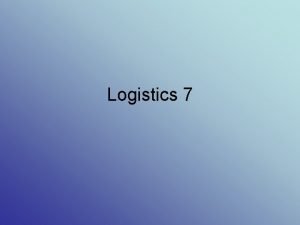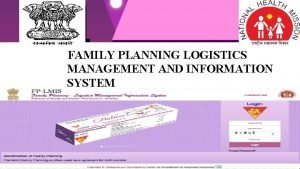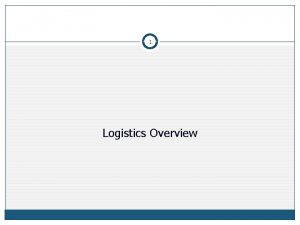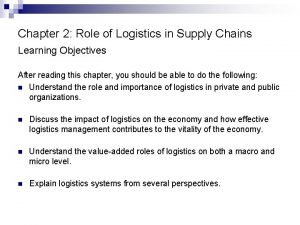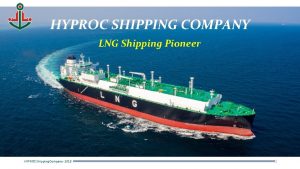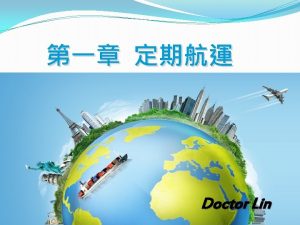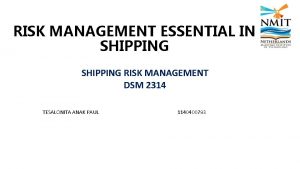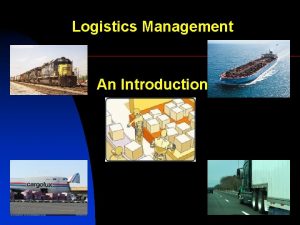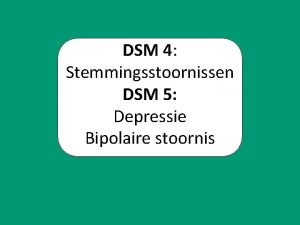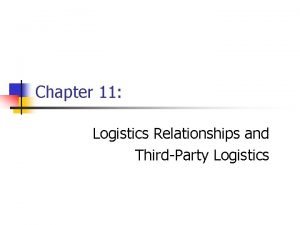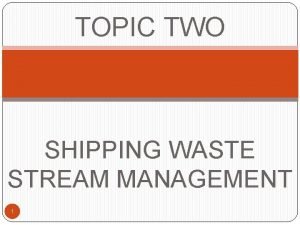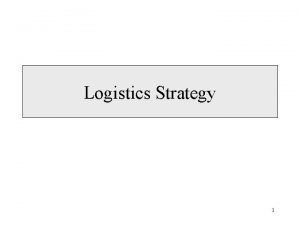DSM 2315 Shipping and Transport Logistics Management 4














































- Slides: 46

DSM 2315 Shipping and Transport Logistics Management

4. Packaging of Cargo 4. 1 Functions of packaging

Functions of packaging • Primary • Secondary • Tertiary

Primary Functions (Concerns the technical nature of packaging) • Protective Function • The inward and outward protective function primarily places demands upon the strength, resistance and leak-proof properties of transport packaging. • The inward protective functions • to ensure full retention of the utility value of the packaged goods • to protect the goods from loss, damage and theft • to withstand the many different static and dynamic forces to which it is subjected during transport, handling and storage operations. • The outward packaging functions • to protect from climatic conditions, such as temperature, humidity, precipitation and solar radiation • to prevent any environmental degradation by the goods

Primary Functions (Concerns the technical nature of packaging) (con’t) • Storage Function • The packaging materials and packaging containers required for producing packages must be stored in many different locations both before packaging of the goods and once the package contents have been used. • Packaging must thus also fulfill a storage function.

Primary Functions (Concerns the technical nature of packaging) (con’t) • Loading and Transport Function • Packaging has a crucial impact on the efficiency of transport, handling and storage of goods. • Packaging should be designed to be easily handled and to permit spacesaving storage and stowage. • The most efficient method of handling general cargo is to make up cargo units; package dimensions and the masses should be tailored to the dimensions and load-carrying capacity of standard pallets and containers. • The loading and transport function places requirements upon the external shape of the package, upon the mass of the goods accommodated inside and upon the convenient use of packaging aids.

Secondary functions (concerns the communications of packaging) • Sales Function • to enable or promote the sales process and to make it more efficient • Promotional Function • Promotional material placed on the packaging is intended to attract the potential purchaser's attention and to have a positive impact upon the purchasing decision • While product awareness is indeed generated along the transport chain, excessive promotion also increases the risk of theft.

Secondary functions (concerns the communications of packaging) (con’t) • Service Function • The various items of information printed on packaging provide the consumer with details about the contents and use of the particular product. • Examples are the nutritional details on yogurt pots or dosage information on medicines. • The package may also perform a further function once the contents have been used (e. g. storage container, toy).

Secondary functions (concerns the communications of packaging) (con’t) • Guarantee Function • By supplying an undamaged and unblemished package, the manufacturer guarantees that the details on the packaging correspond to the contents. • The packaging is therefore the basis for branded goods, consumer protection and product liability. • There are legislative requirements which demand that goods be clearly marked with details indicating their nature, composition, weight, quantity and storage life.

Tertiary functions (additional functions) • Additional Function • The additional function in particular relates to the extent to which the packaging materials or packaging containers may be reused once the package contents have been used. • The most significant example is the recycling of paper, paperboard and cardboard packaging as waste paper.

4. Packaging of Cargo 4. 2 Types of packing

Types of packing Container Type Character Application Standard 20' - Max. Payload: 28, 23 T Suitable for any (Tonne) general cargo. 20’x 8’ 6” Has various lashing devices 40' - Max. Payload: 26, 7 T on the top and 40’x 8’ 6” bottom 40’x 8 x 9’ 6” (HC) longitudinal rails and corner post. 45’ - Max. Payload: 27, 45 T 45’x 8’x 9’ 6” (HC) Figures

Types of packing Container Type Character Application Hardtop 20' - Max. Payload: 27, 89 T 20’x 8’ 6” Equipped with a removable steel roof. Especially for heavy loads and over height cargo. Loading through roof opening and doorway by swing outdoor header 40' - Max. Payload: 25, 78 T 40’x 8’ 6” 40’x 8 x 9’ 6” (HC) Figures

Types of packing Container Type Character Open Top 20' - Max. Payload: 28, 13 T 20’x 8’ 6” Application Figures With removable tarpaulin. Used especially for 40' - Max. Payload: 26, 63 T over height 40’x 8’ 6” cargo. Loading 40’x 8 x 9’ 6” (HC) either from top side or door side Removable tarpaulin and by swing outdoor roof bows. Easy top loading header. of over sized cargo.

Types of packing Container Type Flat Rack Character Application 20' - Max. Payload: 31, 26 T 20’x 8’ 6” Especially for heavy loads and over width cargo. 40' - Max. Payload: 26, 28 T 40’x 8’ 6” 40'HC-Max. Payload: 39, 30 T 40’x 8 x 9’ 6” (HC) Fixed or collapsible end walls. For over-width and heavy cargo. Figures

Types of packing Container Type Character Application Platform 20' - Max. Payload: 31, 26 T 20’x 8’x 2’ Especially for heavy loads and oversized cargo. 40' - Max. Payload: 39, 30 T 40’x 8’x 2’ For extra length and heavy cargo Figures

Types of packing Container Type Character Application Figures Ventilated 20' - Max. Payload: 27, 99 T Especially for cargo which needs ventilation.

Types of packing Container Type Character Application Refrigerated 20' - Max. Payload: 27, 45 T 20’x 8’ 6” Reefer containers do have their own electrically operated cooling / heating unit. The power supply is provided by ship's electrical plant, by terminal or by "clipon" diesel generator. (and heated) (Thermal 40' - Max. Payload: 29, 40 T Container capable 40’x 8’ 6” of transporting cargo at temperatures For cooling, freezing of foods or usually from -25 C chemicals or ground level cold to 25 C. ) storage 40' HC - Max. Payload: 29, 88 T 40’x 8’x 9’ 6” For extra capacity of cargo requiring cooling or freezing or ground level Figures

Types of packing Container Type Insulated Character Application 20' - Max. Payload: 21, 45 T 20’x 8’ 6” These containers do not have their own cooling facility. The cooling / heating is supplied by an onboard plant, by terminal or by a "clip-on" reefer unit. 40' - Max. Payload: 26, 63 T 40’x 8’ 6” Figures

Types of packing Container Type Character Application Figures Tank 20’x 8’ 6” (17, 500 – 25, 000 For the transport liters) of liquid food, e. g. : Alcohols, For transportation of liquid Juices, Edible Oils, chemicals and food stuffs. Food Additives

The Main Advantages of Using Containers As A Packaging Unit • Use of containers reduces loss, pilferage and damage claims significantly. • It eliminates a great deal of paper work related to shipments. • It expedites door-to-door pick-up and delivery service of cargo by reducing the time for loading and unloading operations. • It eliminates multiple handling of cargo because a container is handled as a unit. • The consolidation of small loads into a unit load is possible with a container, leading to economy in freight cost

The Main Advantages of Using Containers As A Packaging Unit (con’t) • Improvement relating to handling, marketing and pattern of packaging is made possible by the container. • It is possible to reduce the cost of packaging because of possibilities of placing goods without heavy packaging inside the container without any risk of damage in transit. • A container combines all the advantages of various mode of transport by rail, road and sea. • Containerization has led to improvement in the construction of boxes or containers, and quick turn-round of modes of transport – whether ship, rail, road- which leads to economy in the cost of transport.

The Main Disadvantages of Using Containers As Packaging Unit • Containerization increases the fuel costs of transport and reduces the capacity of the transport as the container itself must be shipped around not just the goods. For certain bulk products this makes containerization unattractive. • When transporting containers through railways, containers cannot be stacked in layers due to vertical height limitations. As a result transportation through railways sometimes becomes difficult • Containers occasionally fall from the ships during storms. It is estimated that over 10, 000 containers are lost at sea each year.

4. Packaging of Cargo 4. 3 Unitized, palletised and container cargo

Principles of Unit Loads a. The combining of numerous items into a unit load of appropriate size which can be handled with available equipment and within existing facilities is most economical. i. ii. The larger the number of items handled as a unit, the smaller the handling cost per item. The savings by this method can offset the initial cost, operation, and maintenance of the mechanical equipment required to lift and transport the heavier loads. b. To minimize double handling of material, non-palletized items which are received in quantities suited to palletization will be palletized at the earliest practicable point during the receipt process.

Principles of Unit Loads c. Practical limits to the application of unit loads include the physical characteristics of the items, size of pallet, storage area, unit load elevators (size and capacity), size of doors, capacities of available Material Handling Equipment (MHE), and aisle widths. i. Generally, large rigid items such as lumber, pipe, and bar stock need not be palletized, but can be bound into unit loads for mechanical handling as much tonnage as possible will be hauled in a single trip. ii. The unit load principle can also be applied to the design of the container for individual units or items. For example, a 50 -pound unit can be handled in less time and at less cost per pound than two 25 -pound units. However, the weight of any unit or container that must be eventually manhandled will be limited by the strength of the average man. For this reason, the gross weight of these containers or units should be limited to no more than 70 pounds where possible.

Cartons Palletized For Unit Handling

Examples of Nonpalletized Unit Loads • Nonpalletized unit load of lumber • Nonpalletized unit load of boiler tubes

Palletized cargo The advantage of correctly palletized cargo is that cargo handling can be mechanized and, provided the pallets fit the container, securing can largely be dispensed with. Provisos are that the pallets are sensibly packed, the dimensions of the packed pallets in the lengthwise and crosswise directions each correspond to fractions of the internal container width, length and height and the pallets are stackable. If these conditions are met, and strictly speaking only if they are, can cargo be described as "fully palletized". Many cargo handling and packing companies offer special terms for fully palletized cargoes.

Packing a container with palletized cargo without interlayer dunnage • If the packages are strong enough, they can be stacked on top of one another without interlayer dunnage.

Packing palletized hazardous materials with interlayer dunnage • If the packages are strong enough, they can be stacked on top of one another without interlayer dunnage.

Packing a 40' container with palletized cargo

Deficiently packed palletized cargo • The shipping packages are not well packed. Interlayer dunnage is essential with the type of pallet base used. The gaps left are too big.

4. Packaging of Cargo 4. 4 Packaging of dangerous

IMDG Code For the purposes of this Code, a "unit load" means a number of packages that are: • placed or stacked on and secured by strapping, shrink-wrapping or other suitable means to a load board such as a pallet; or; • placed in a protective outer enclosure such as a pallet box; or; • permanently secured together in a sling.

IMDG Code (con’t) • 10. 18. 2 packages that contain hazardous goods, that are permitted to be transported in accordance with the code, may only be transported in unit loads if the following conditions are fulfilled. • 10. 18. 2. 1 It may occur that the packages in a unit load will need to be separated. In this event, it must be ensured that the individual packages can be handled safely. • 10. 18. 2. 2 The unit loads should be compact, have as regular a form as possible, and for the most part, vertical sides. The top of the unit load should be level. It must be possible to stack the unit loads. They must be constructed and secured in such a way that it is unlikely that the individual shipping packages can become damaged. • 10. 18. 2. 3 The unit loads must be sufficiently strong to withstand repeated loading and stowing operations and they must be able to bear unit loads with a similar specific mass which are stacked on them to a height commonly occurring during transportation.

Deficiently packed palletized cargo • Packing gaps = packing deficiencies

Deficiently packed palletized cargo

Deficiently packed palletized cargo Unsecured cargo Secured cargo

4. Packaging of Cargo 4. 5 Marking of goods

Specifications • ISO – International Organization for Standardization • ISO (International Organization for Standardization) is an independent, nongovernmental membership organization and the world's largest developer of voluntary International Standards. We are made up of our 165 member countries who are the national standards bodies around the world, with a Central Secretariat that is based in Geneva, Switzerland. • • ISO 668: 2013 Series 1 freight containers—Classification, dimensions and ratings ISO 6346: 1995 Freight containers—Coding, identification and marking ISO 1161: 1984 Series 1 freight containers—Corner fittings—Specification ISO 1496 -1: 2013 Series 1 freight containers—Specification and testing—Part 1: General cargo containers for general purposes

Specifications • Each container is allocated a standardized ISO 6346 reporting mark (ownership code), four characters long ending in either U, J or Z, followed by six numbers and a check digit. • The ownership code for intermodal containers is issued by the Bureau International des Containers et du Transport Intermodal (41 rue Réaumur, 75003 - Paris France), hence the name BIC-Code for the intermodal container reporting mark. • So far there exist only four-letter BIC-Codes ending in "U".

Identification system • Like any vehicle, every container has an identification system based on a unique registration number. • The identification system for containers (ID) is based on a series of letters and numbers that represent the owner’s code, the serial number and the code for the country of origin. • The registration number is given on all four sides of the container which makes it possible to identify its owner, and to identify the contents of the container. • Other important information about the container is also provided by these numbers. • All containers are, therefore, required to have these identification numbers and letters. • A system also been developed to check this information, and details of the type and dimensions of containers is also expressed in figures.

Example of container ID

Identification system (con’t) • The container ID is composed of several fields, including the following fields: 1. The shipping company (e. g. , “UXX”) 2. The equipment category (always “U” for freight containers, "Z" or "C" for chassis) 3. The serial number of the container (e. g. , “ 423697”). 4. The check digit of the first 3 fields (e. g. , ” 0”) 5. The container type (e. g. , ”SE 4310”)

Identification system (con’t) • Only the first 3 fields are relevant to the identification of the container, and represent a unique identification number for each shipping container. In the above case, this ID is “UXXU 423687”. • The shipping company field ("UXX"in the example) is verified against a pre-defined list of known companies. • Additionally, the second field ("U") is always verified. • The check digit is used in order to verify the entire 10 -character identification number. • If the check digit is not identified, only the 10 characters are compared and reported. • If it is recognized and tested for correctness, it will also be reported (a "0" in the above case). • The container type (in the above example, ”SE 4310”) is not part of the ID and is not identified or transmitted.
 Communication disorders (dsm-5 ppt)
Communication disorders (dsm-5 ppt) Dsm 5 vs dsm 4
Dsm 5 vs dsm 4 Dsm 5 vs dsm 4
Dsm 5 vs dsm 4 Dsm 4 y 5 diferencias
Dsm 4 y 5 diferencias Sdl 2315
Sdl 2315 Dsm ship management
Dsm ship management Trampliner
Trampliner Sssl port
Sssl port Uniport symport antiport
Uniport symport antiport Primary active transport and secondary active transport
Primary active transport and secondary active transport Active transport image
Active transport image Dsm ship management
Dsm ship management Dsm shipbrokers
Dsm shipbrokers Now answer the questions
Now answer the questions Active vs passive transport venn diagram
Active vs passive transport venn diagram Unlike passive transport, active transport requires *
Unlike passive transport, active transport requires * Primary active transport vs secondary active transport
Primary active transport vs secondary active transport Bioflix activity membrane transport active transport
Bioflix activity membrane transport active transport Bioflix activity membrane transport active transport
Bioflix activity membrane transport active transport Risk management in shipping industry
Risk management in shipping industry Functional components of ecrm
Functional components of ecrm Logistics and channel management
Logistics and channel management Fcsd packaging and shipping guide
Fcsd packaging and shipping guide Component of physical distribution
Component of physical distribution Global logistics and supply chain strategy
Global logistics and supply chain strategy Difference in dsm 4 and 5
Difference in dsm 4 and 5 Granularity in distributed shared memory
Granularity in distributed shared memory Army logistics management college
Army logistics management college Army logistics management college
Army logistics management college Performance cycle uncertainty
Performance cycle uncertainty Sinotrans-ksa
Sinotrans-ksa Logistics management introduction
Logistics management introduction Council of logistics management
Council of logistics management Objectives of logistics management
Objectives of logistics management Objectives of logistics management
Objectives of logistics management Family planning logistics management information system
Family planning logistics management information system Objectives of logistics management
Objectives of logistics management Value chain and supply chain difference
Value chain and supply chain difference Logistics planning triangle
Logistics planning triangle Role of logistics management
Role of logistics management What is logistics
What is logistics Integrated logistics management
Integrated logistics management Dsm 5 autismo
Dsm 5 autismo Pdm vs dsm
Pdm vs dsm Somatization disorder dsm 5
Somatization disorder dsm 5 Sensory processing disorder dsm
Sensory processing disorder dsm Personality disorders dsm 5
Personality disorders dsm 5
